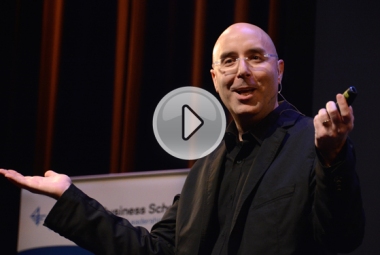In 1967, IBM founder Thomas J. Watson approached The Metropolitan Museum of Art in New York City with a then unheard of offer… to donate computers to the Museum. The Met declined. Ironically, one particular curator doubted that a computer would be a “time-saving device.”
This resistance to joining the technology-driven world may now seem as dated as a piece from the Met’s Ancient collection, given that 2011 marked the year the Met lifted its cell phone ban and redesigned its website for optimal viewing on smartphone screens. And in 2013, the Museum’s first-ever Chief Digital Officer, Sree Sreenivasan, was brought on board to digitally transform the museum experience.
Art and technology have long been bedfellows—from Michelangelo with his chisel and hammer to Ryan Trecartin with his mixed-media video installations. Speaking at the BRITE ’15 conference, Sreenivasan, who is also formerly Columbia University’s first Chief Digital Officer, noted, “Any art you see today is because the artist used the right technology at the right time—the right canvas, the right marble, the right tools.”
with his mixed-media video installations. Speaking at the BRITE ’15 conference, Sreenivasan, who is also formerly Columbia University’s first Chief Digital Officer, noted, “Any art you see today is because the artist used the right technology at the right time—the right canvas, the right marble, the right tools.”
Sreenivasan understands firsthand the challenges of keeping pace with a rapidly evolving digital world, particularly at renowned institutions with such historical significance. At BRITE ’15, Sreenivasan shared insights from digital, mobile and social lessons learned during his tenure with The Metropolitan Museum of Art. He explained that a consistent strategy across mobile and social media platforms, like the one employed by the Met, is pivotal to staying relevant and continuing to meet consumers’ day-to-day desires in this age of constant change and innovation.
It’s no secret that mobile is now more important than ever. In September 2014, the Met launched its first app. Sreenivasan wanted to provide Museum visitors with an app that would speak more directly to their interests, “instead of putting the whole museum in [their] pocket.” Art enthusiasts can track upcoming events, save their favorite works of art to their smartphones and tweet about their favorite exhibitions. Within two weeks of its release, the app was downloaded more than 100,000 times and has been hailed as one of the Apple Store’s “Best New Apps.”
Though his title is Chief Digital Officer, Sreenivasan considers himself to be more of a “Chief Listening Officer,” observing the varying interests and behaviors of the institution’s 6 million museum attendees and the 30 million unique online visitors a year. “That’s a lot of listening,” quipped Sreenivasan.
One result of all that listening was a commitment to creating hashtags for each exhibition. No small feat, considering the Met currently houses over 2 million works of art. Sreenivasan credits the audience who tweeted their wishes for an intuitive way to share their museum experiences.
Sreenivasan notes that audiences are becoming increasingly “culturally curious,” eager to glimpse the behind-the-scenes of installations. The Met answered this growing need by displaying online the restoration of one of its most coveted acquisitions, Everhard Jabach (1618–1695) and His Family, ca. 1660, by French artist Charles Le Brun.

Through the Met’s social channels, fans and followers were able to view this typically veiled process from anywhere in the world. “Instead of working on it in secret for a year and then putting it out, we’ve already started blogging about it.” Viewer comments have ranged from questions surrounding oil paint solvents to expressions of gratitude for the ability to witness art history in the making.

One such commenter said, “Thank you for giving us the opportunity to see this fascinating work…. [R]eading about it does not convey the same image.”
Another asked, “How many more do we have to look forward to? I’m anxious to see the work in the gallery, but not so much that I wish you to rush, rush. I am enjoying my time!”
When it comes to choosing social media platforms, Sreenivasan advised that, depending on your business, you don’t always have to be on every network, and “there is no reason to be first [on a social media platform]. Join when it makes sense for you.” Sreenivasan reminded the audience of the potential minefield of controversy that social media platforms can become. “Almost everyone will miss everything you do until you make a mistake,” he cautioned. In the October 2014 New York Times article, Museums Morph Digitally, Amit Sood, director of the Google Cultural Institute in London, echoed this sentiment, “I learned not to underestimate museums. They were a little slow to the digital game. That’s a good thing.”
Slow to the digital game, perhaps, but well-conceived. Sreenivasan’s digital strategy at The Metropolitan Museum of Art has allowed this nearly 150 year-old institution to remain a timeless cultural mainstay while continually reinventing how it delivers art to art enthusiasts, based on their desires as they express them, from their smartphones to the front steps of the Museum itself.
BY THEO LEGRO








